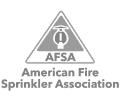How Do Fire Hydrants Work?

Fire hydrants are a common sight throughout the Houston area, standing ready to assist in the event of a fire emergency. These bright, durable fixtures are essential components of a strong fire safety infrastructure, yet many people don’t know how they actually work or the role they play in protecting our community.
In this blog post, the fire safety experts at Kauffman Co. Fire & Safety shed light on the importance of fire hydrants, how they work, and the meticulous planning involved in their installation and maintenance.
The Basic Components of a Fire Hydrant
A fire hydrant is made up of several key components, each serving a specific purpose to ensure proper functionality during a fire. Here are the main elements of a well-maintained fire hydrant system:
- Bonnet: The top part of the hydrant that covers the operating mechanism, the bonnet often has a pentagonal or hexagonal shape to prevent tampering and is typically color-coded to indicate the water flow rate available.
- Nozzle caps: These caps cover the outlets (or nozzles) where hoses are attached and are responsible for protecting the threads from damage and preventing debris from entering the hydrant.
- Barrel: The vertical body of the hydrant, which extends above and below ground, the barrel houses the internal stem and provides a passage for water.
- Stem: An internal rod that connects the operating nut to the valve, the stem opens or closes the valve.
- Valve: Located at the base of the hydrant, the valve controls the flow of water from the water main to the hydrant outlets.
services from Kauffman
How Fire Hydrants Work
Fire hydrants are integral to the municipal water supply system. They’re directly connected to high-pressure water mains that run beneath our streets. Here’s how a fire hydrant typically operates:
- Opening the valve: Firefighters use a special tool, such as a hydrant wrench or a specific hydrant key, to turn the operating nut on the bonnet. This rotates the internal stem.
- Water flow: As the stem turns, it lifts the valve at the base of the hydrant. This valve, when opened, allows water to rush out from the high-pressure water main and flow into the hydrant barrel.
- Nozzle connection: Fire hoses are then connected to the hydrant nozzles, allowing firefighters to direct the water flow to extinguish fires.
Where Are Fire Hydrants Installed?
Fire hydrant placements are strategically planned to maximize accessibility and effectiveness during a fire. In most cases, fire hydrants are along streets and in public areas where they’re easily visible and accessible to firefighters.
Local fire codes and regulations dictate the intervals at which hydrants are installed. This spacing ensures that a hydrant is always within a reasonable distance from any potential fire hazard.
Strategic placement is essential for ensuring that firefighters can quickly locate and access hydrants during emergencies, minimizing response times and maximizing the effectiveness of firefighting efforts.
Who Can Use Fire Hydrants?
While fire hydrants are primarily used by firefighters and other trained professionals, their use is regulated to ensure safety and prevent misuse.
Unauthorized use of fire hydrants is illegal and may result in significant fines. In some cases, however, hydrants may be used for purposes such as flushing water mains or providing a temporary water supply, but such use typically requires special permission and oversight.
Maintenance & Testing of Fire Hydrants
Regular maintenance and testing are essential to keep fire hydrants in good working order. Proper fire hydrant maintenance typically entails:
- Opening the hydrant to measure the water flow rate
- Routine inspections to check for visible damage, leaks, and obstructions
- Lubrication of internal components, such as the stem and valve
Routine maintenance ensures that hydrants function properly during emergencies and helps extend their operational lifespan.
Houston Fire Hydrant Testing With Kauffman Co.
Fire hydrants play a critical role in the safety of our community. At Kauffman Co., we specialize in providing continued maintenance for fire hydrant systems, ensuring they’re fully functional during an emergency.
By keeping fire hydrants well-maintained, we help Houston homeowners stay safe for the long term.
Schedule fire hydrant maintenance or 24/7 emergency repair by contacting our team online today.
services from Kauffman
















